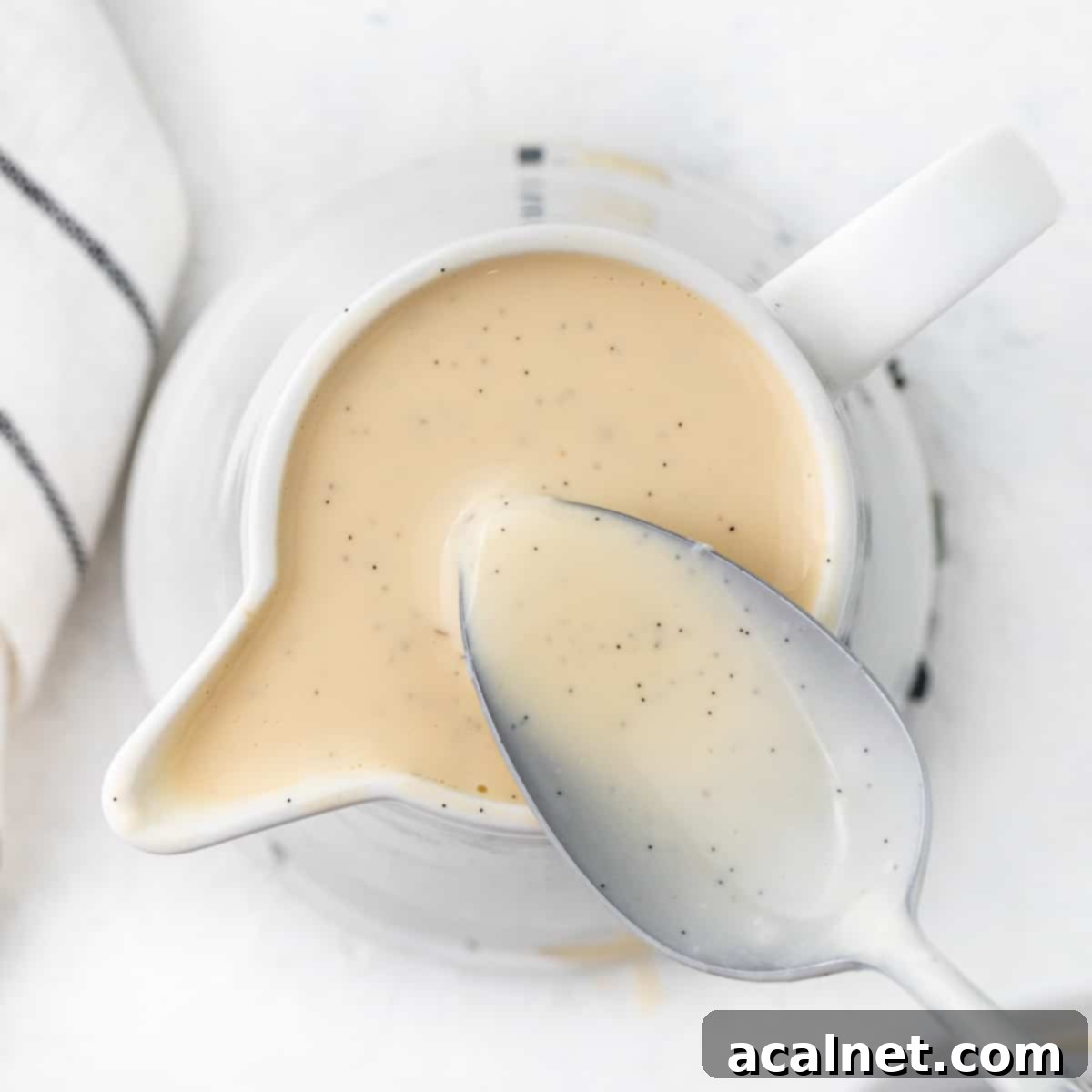Mastering Crème Anglaise: Your Ultimate Guide to Vanilla Custard Sauce
Step into the elegant world of French patisserie with Crème Anglaise, a foundational recipe renowned for its silky texture and delicate vanilla flavor. This versatile vanilla custard sauce, meaning “English Cream” in French, is far more than just a topping. It serves as a light, fragrant accompaniment to countless desserts or as a rich base for more complex creations like luxurious homemade ice cream, classic crème brûlée, or airy Bavarian cream. What’s truly remarkable is how accessible this seemingly sophisticated French classic is: crafted from just four basic ingredients, it comes together in approximately 15 minutes of active preparation, making it an ideal recipe for both novice and experienced bakers alike.
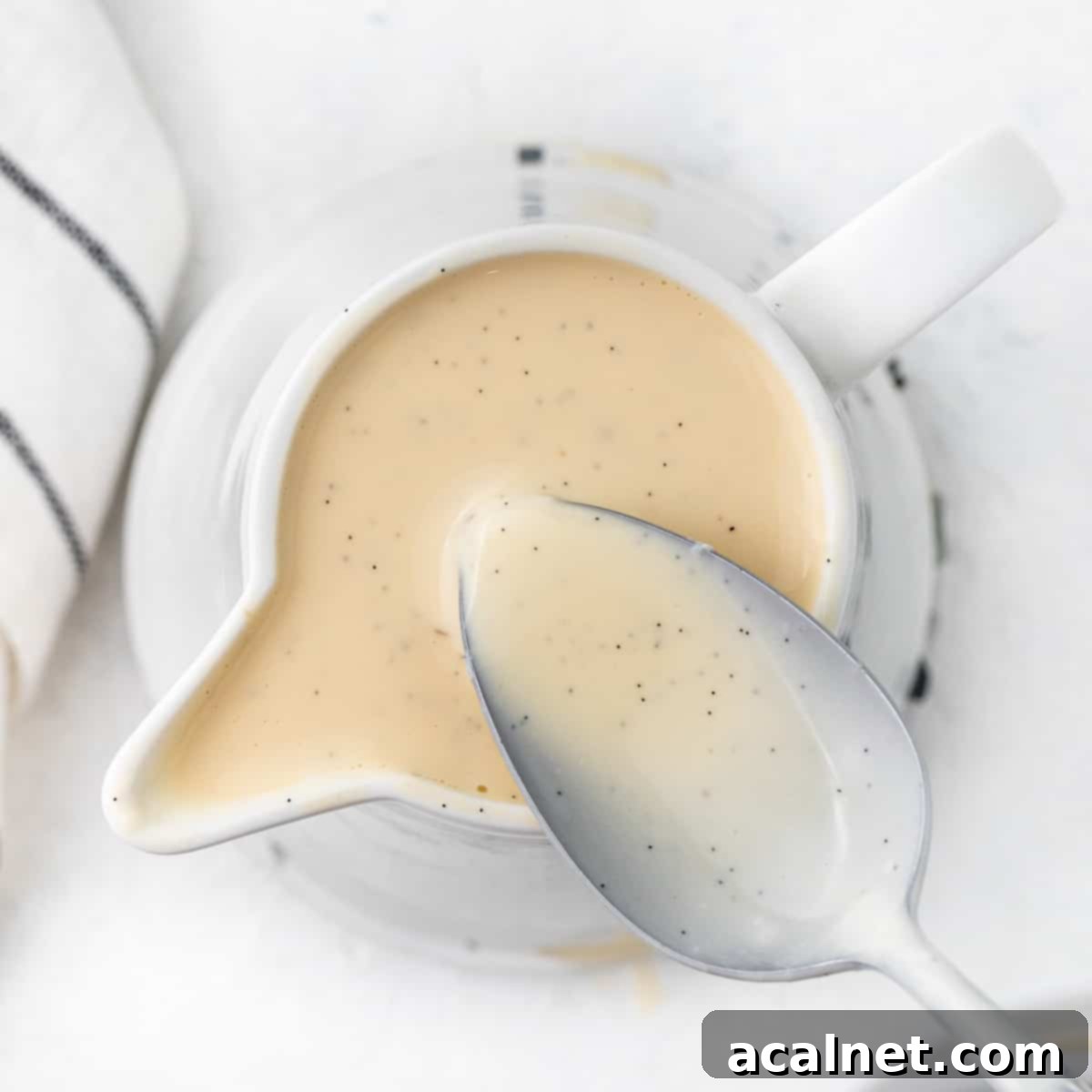
Why Crème Anglaise is a Must-Have Recipe in Your Repertoire
Crème Anglaise stands out as one of those fundamental yet incredibly adaptable French pastry recipes. Its allure lies in its simplicity and the sheer elegance it brings to any dessert. Made primarily from just three core ingredients – milk, egg yolks, and sugar – and beautifully infused with vanilla, it transforms into a deliciously fragrant, lightly sweetened, and remarkably smooth sauce. This pouring custard boasts an inimitable thin and velvety texture, making it the quintessential drizzle for everything from delicate cakes and pastries to fresh seasonal fruits.
Beyond its role as a sublime sauce, mastering this basic French cream is a gateway to a world of other homemade desserts. Once you’ve perfected Crème Anglaise, you unlock the ability to effortlessly create luxurious homemade ice creams, rich crème brûlées, and delicate Bavarian creams, among many other creamy delights. It’s a foundational skill that elevates your baking journey, allowing you to craft professional-quality desserts with confidence and flair.
What is Crème Anglaise: The Essence of French Custard
“Crème Anglaise,” literally translating to “English Cream” in French, is a classic preparation in French pastry. This elegant, thin custard sauce is meticulously crafted by cooking milk, egg yolks, and sugar over gentle heat until it thickens to a pourable consistency. While it is classically flavored with aromatic vanilla bean, its versatility extends to delicious variations infused with coffee, rich chocolate, or vibrant fruit purées. Unlike its thicker cousin, Crème Pâtissière (pastry cream), Crème Anglaise achieves its luscious texture solely through the coagulation of egg yolks, without the addition of any starches like cornstarch or flour. This key difference results in a distinctively lighter, thinner, and more fluid consistency, making it ideal for pouring rather than filling.
Understanding its unique characteristics is crucial. While the preparation methods share similarities with other custards, the absence of a thickening agent other than egg yolks gives Crème Anglaise its signature delicate and flowing quality. This makes it an indispensable component for numerous French desserts, serving as a sophisticated sweet base for Ice Cream, the decadent topping for Crème Brûlée, or the creamy foundation for Bavarian Cream. Its ability to enrich and enhance without overwhelming makes it a true culinary chameleon.
Essential Ingredients for Vanilla Bean Crème Anglaise
Creating an impeccable Crème Anglaise starts with high-quality ingredients. While the list is short, each component plays a vital role in achieving that perfect smooth texture and rich flavor.
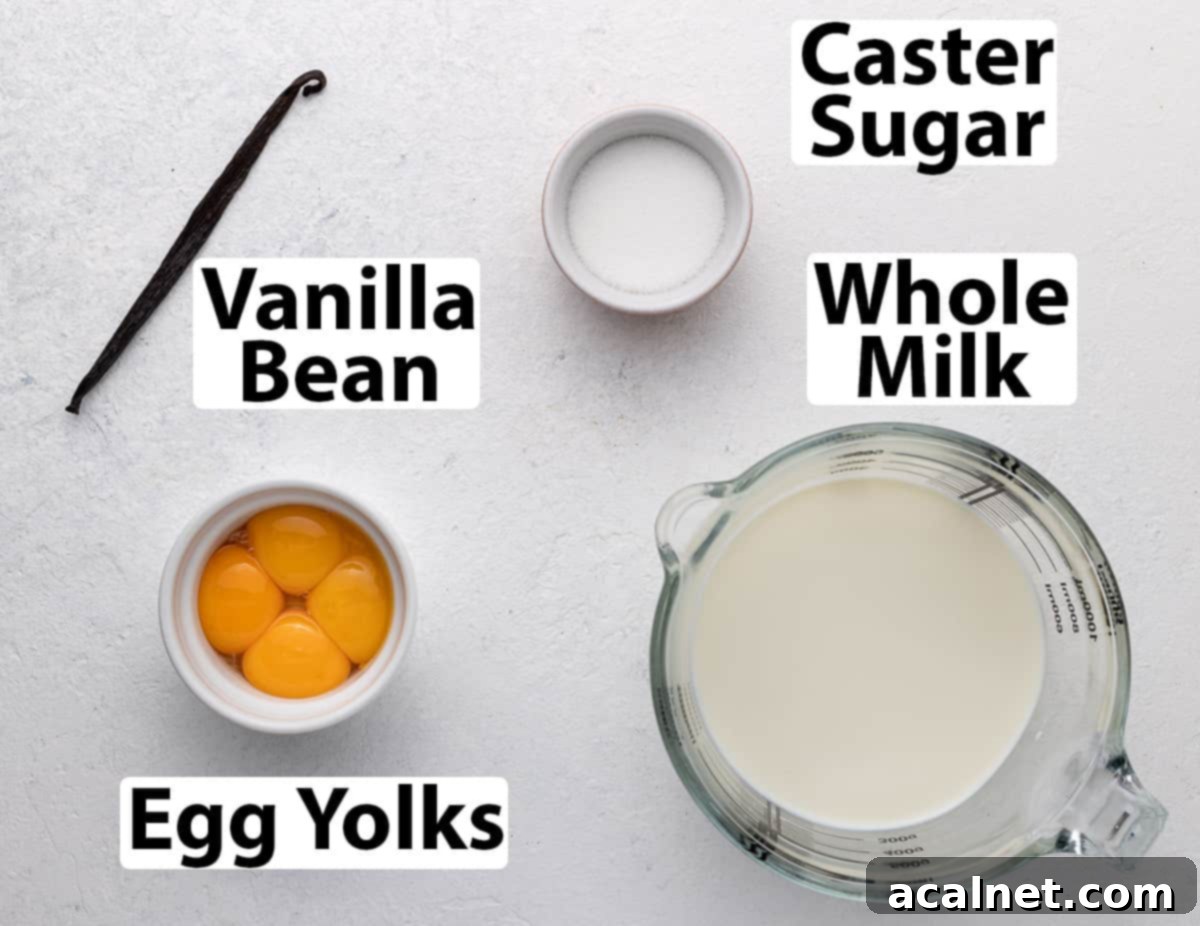
Scroll down to the recipe card below for all quantities and precise measurements.
- Whole Milk (Full Cream Milk): Opt for whole milk (around 3% fat content) to achieve the richest flavor and most desirable creamy texture. The higher fat content contributes significantly to the sauce’s luxurious mouthfeel and depth.
- Caster Sugar (Superfine White Sugar): This recipe uses a moderate amount of caster sugar, providing a delicate sweetness that allows the vanilla to shine. If you prefer a more intensely sweet dessert, feel free to slightly increase the quantity of sugar to your personal taste.
- Egg Yolks: These are the sole thickening agent in Crème Anglaise, so their quality is paramount. Always use yolks from large, fresh eggs, and crucially, ensure they are at room temperature. Cold egg yolks can curdle quickly when mixed with warm milk, leading to a lumpy custard. Don’t discard those leftover egg whites! They can be beautifully repurposed for other recipes, such as light and airy Financiers or meringues.
- Vanilla Bean: For the most exquisite and authentic flavor, a fresh vanilla bean is highly recommended. You’ll utilize both the fragrant scraped seeds from inside the bean and the remaining pod to infuse the milk. Allowing the vanilla to steep in the warm milk for at least 10 to 15 minutes is vital for extracting maximum flavor and creating that signature aromatic profile.
Substitution Notes for Your Custard
- **For a Thicker, Richer Sauce**: If you desire a more decadent and robust Crème Anglaise, consider substituting half of the whole milk with thickened (heavy) cream or half-and-half. This will increase the fat content, yielding a creamier, slightly thicker consistency.
- **Vanilla Alternatives**: While a fresh vanilla pod offers unparalleled flavor and those beautiful speckled aesthetics, you can substitute it with a high-quality vanilla paste if a bean isn’t available. Vanilla extract can also be used, but be aware that you might lose some of the depth of flavor and the visual appeal of the vanilla bean specks. Ensure you use good quality extract for the best results.
How to Make Crème Anglaise: Step-by-Step, A Simple Guide
Making Crème Anglaise is a straightforward process once you understand the key steps. Follow these instructions carefully for a perfectly smooth and flavorful vanilla custard sauce.
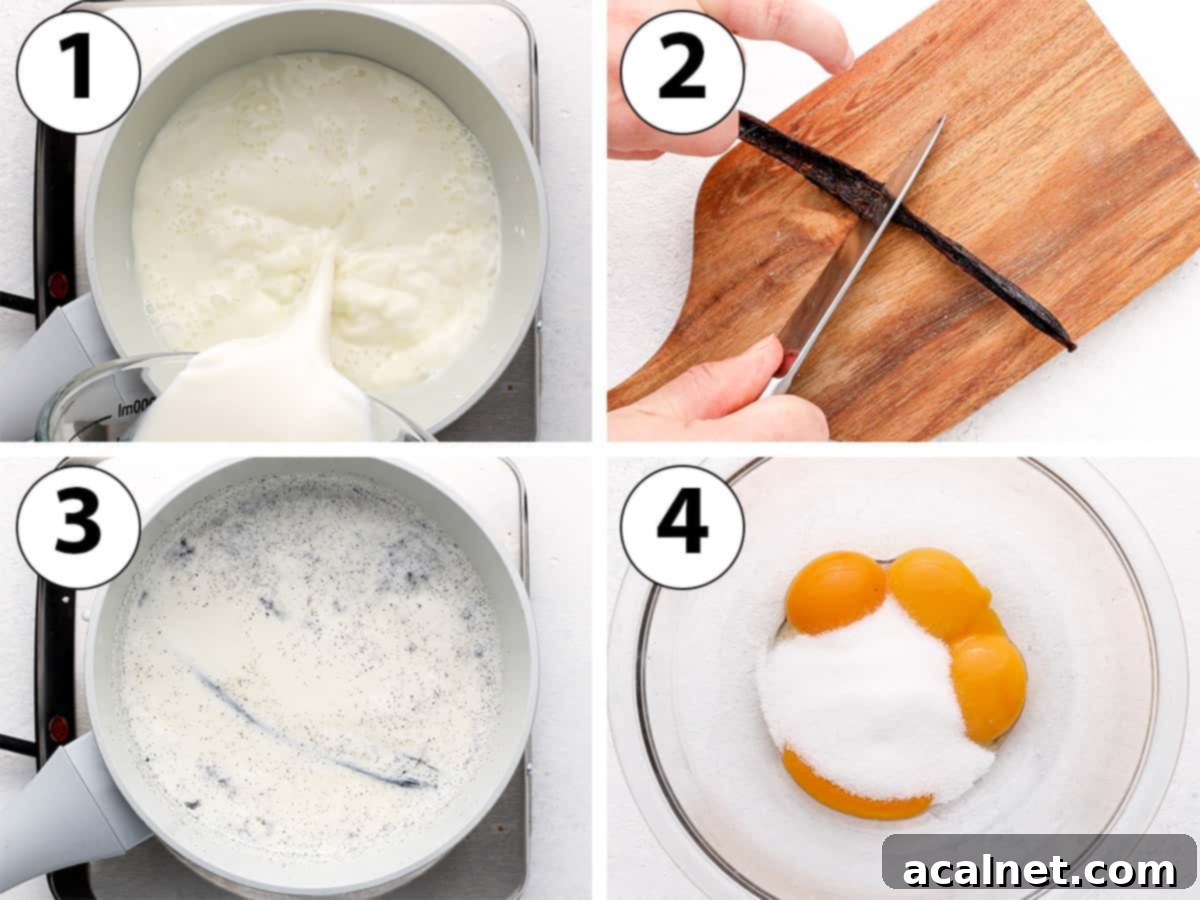
- Prepare the Vanilla Milk:
- Step 1 (Photo 1): Begin by pouring the whole milk into a small to medium-sized saucepan.
- Step 2 (Photo 2): Carefully slice your fresh vanilla bean lengthwise down the middle. Using a small paring knife, gently scrape out the tiny, aromatic seeds from both halves.
- Step 3 (Photo 3): Add both the scraped vanilla seeds and the empty vanilla bean pod to the saucepan with the milk.
- Place the saucepan over low heat and bring the milk to a gentle simmer, stirring occasionally to prevent scorching. As soon as small bubbles begin to form around the edges of the pan (just before it boils), remove it from the heat. Cover the saucepan with a lid and let it rest for 10 to 15 minutes. This crucial resting period allows the vanilla to thoroughly infuse the milk, yielding a deeper, more intense flavor. Afterward, remember to remove the vanilla pod, which can be reused to make homemade vanilla extract or vanilla sugar. If using vanilla paste, this infusion step is not necessary; simply stir it into the warm milk.
- Prepare the Egg Yolk Mixture:
- Step 4 (Photo 4): While the vanilla milk is infusing, combine the room-temperature egg yolks and caster sugar in a large, heat-proof mixing bowl.
- Step 5 (Photo 5): Whisk the egg yolks and sugar together for about 1 minute, or until they are just combined and appear pale yellow. It’s important to avoid over-whisking, as too many air bubbles can affect the final texture of the custard.
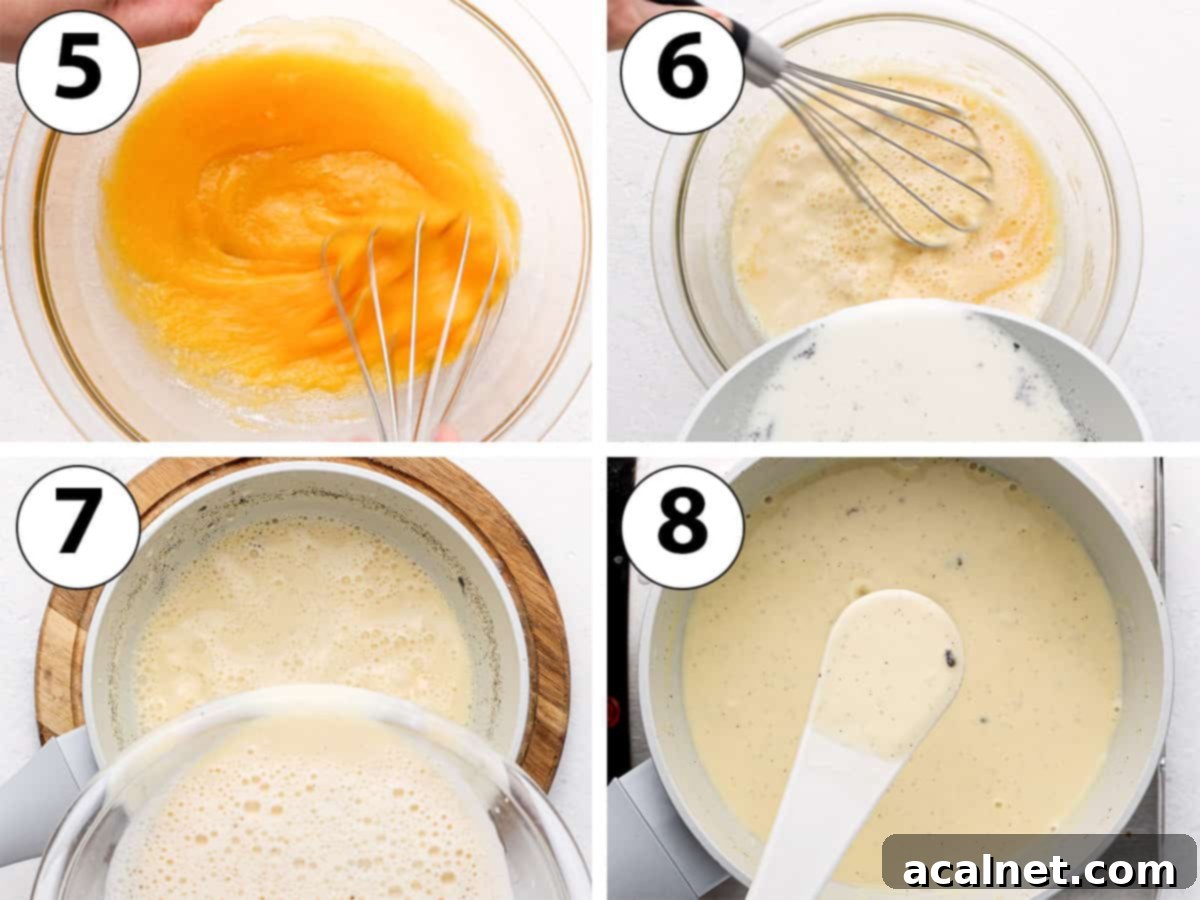
- Temper and Cook the Custard:
- Step 6 (Photo 6): This is the tempering stage. While continuously whisking the egg yolk mixture, slowly and gradually pour the warm vanilla-infused milk into the bowl. This process gently raises the temperature of the eggs, preventing them from scrambling. Pouring hot liquid into cold eggs too quickly will result in a lumpy, curdled custard.
- Step 7 (Photo 7): Once the milk is fully incorporated, pour the entire mixture back into the clean saucepan.
- Step 8 (Photo 8): Place the saucepan over low to medium-low heat. Cook for several minutes, stirring constantly with a heat-proof spatula or wooden spoon. It’s crucial not to let the mixture boil, as this will overcook the eggs and create a lumpy texture.
- The cream will gradually begin to thicken after about 5 minutes, typically when it reaches around 75 degrees Celsius (167°F) and any small bubbles disappear. Continue cooking and stirring for a few more minutes until the custard coats the back of your spoon and registers between 82 and 84 degrees Celsius (180-183°F) on a food thermometer. This is the ideal temperature for perfectly cooked egg yolks without scrambling.
- Finishing Touch:
- Optionally, for an impeccably smooth finish, strain the freshly cooked Crème Anglaise through a fine-mesh sieve into a clean bowl or container. This removes any potential small lumps or tiny bits of cooked egg that may have formed.
Your Vanilla Bean Crème Anglaise is now ready to be enjoyed! It can be served warm immediately or chilled for later use. When storing, transfer the custard to a clean jar or airtight container and place a piece of plastic wrap directly on its surface to prevent a skin from forming. The custard will naturally thicken slightly more as it cools in the refrigerator.
How to Know Your Vanilla Custard Sauce is Perfectly Cooked
Achieving the perfect consistency for Crème Anglaise is all about knowing when it’s done. There are two reliable methods to check if your vanilla custard sauce has been cooked to perfection: the traditional “coating” method and using a precise food thermometer.
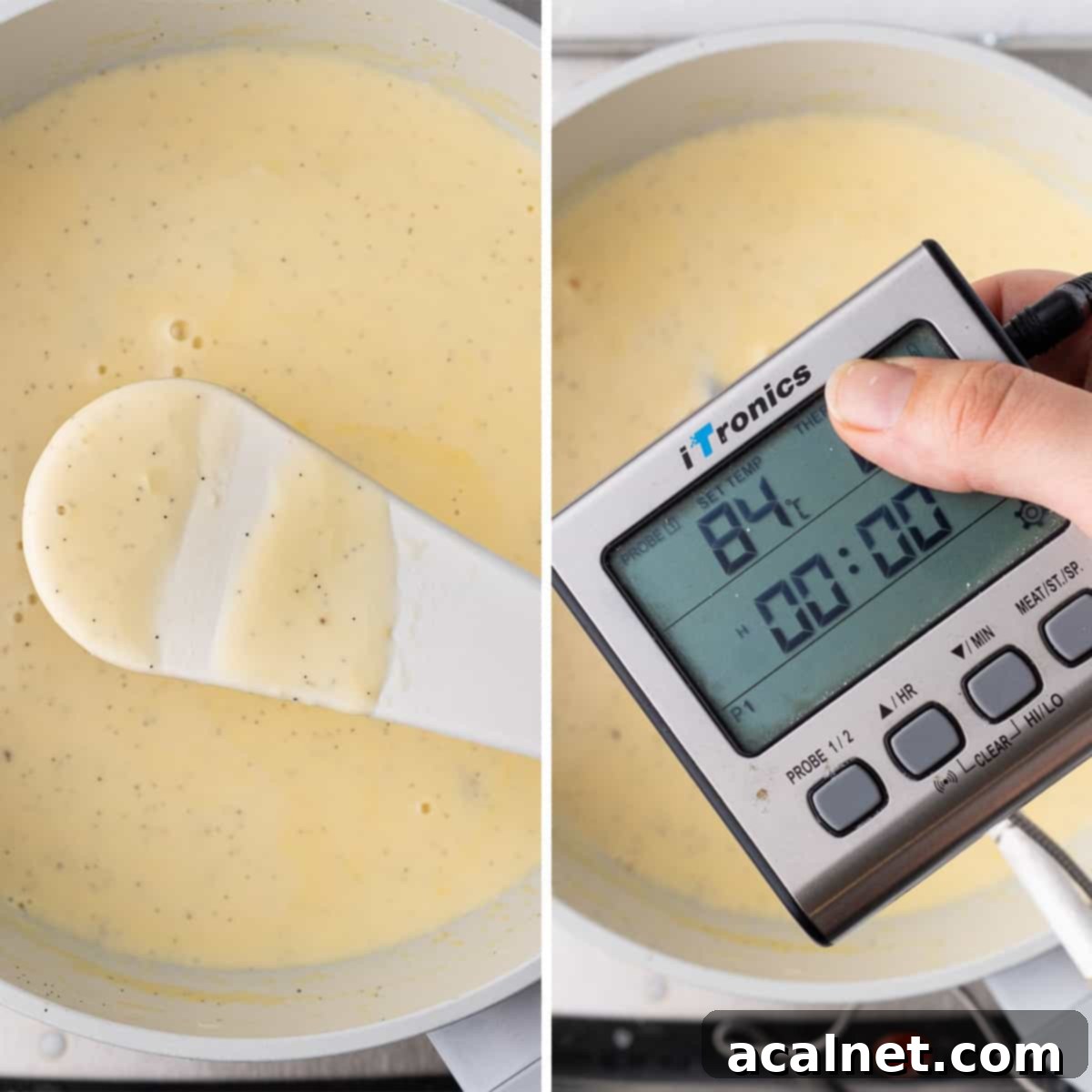
- The “Coating” Method (à la nappe in French): This classic technique involves dipping the back of a spoon or a heat-proof spatula into the cooking cream. Lift the spoon and observe:
- If the mixture is too thin and drips off immediately, it’s not ready.
- If the cream is thick enough to evenly coat the back of the spatula, and you can draw a clean line across it with your finger that holds its shape, your Crème Anglaise is perfectly cooked. This indicates the egg yolks have reached their ideal thickening point.
- With a Food Thermometer: For the most accurate and foolproof results, a food thermometer is your best friend. You want the custard to reach a temperature between 82 to 84 degrees Celsius (180 to 183 degrees Fahrenheit). At this temperature range, the egg yolks are perfectly cooked and safe to consume without beginning to scramble. Ensure you maintain a low to medium heat throughout the cooking process. Cooking too quickly or at too high a temperature will lead to overcooked eggs and a lumpy, undesirable texture. Constant stirring is also key to even cooking and preventing the bottom from scorching.
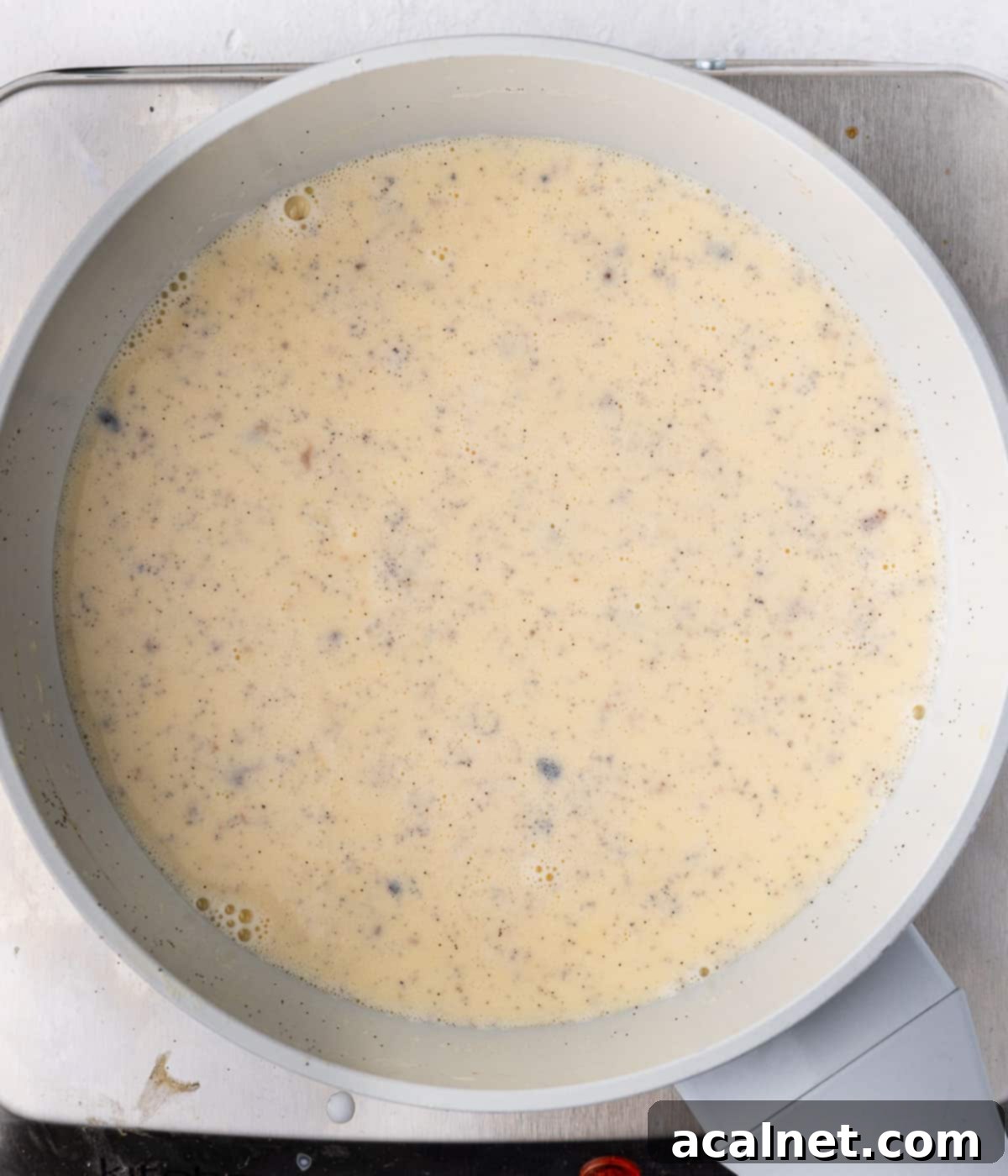
Recipe FAQs: All Your Crème Anglaise Questions Answered
While Crème Anglaise and many other custards (like pastry cream or crème pâtissière) share similar base ingredients and cooking methods, the key differentiator lies in the thickening agent and resulting texture. Crème Anglaise relies solely on egg yolks for its thickening, giving it a delicate, flowing, and pourable consistency. In contrast, a pastry cream uses a starch (such as cornstarch or flour) in addition to egg yolks, resulting in a much thicker, richer cream suitable for filling cakes and tarts. So, if you’re looking for a pourable vanilla dessert sauce, Crème Anglaise is your go-to!
Although this custard is named a “cream,” the classic recipe traditionally calls for milk. You can certainly substitute whole milk with heavy cream (which has a higher fat content, typically 30% or more), but this will result in a thicker, much richer custard with a different texture. For its distinctive light, pouring consistency, milk is preferred. However, if you plan to use Crème Anglaise as a base for desserts that require extra richness and body, such as ice cream or crème brûlée, substituting some or all of the milk with cream is often recommended to achieve the desired final product.
Unfortunately, no. The egg yolks are the primary, and often sole, thickening agent in a traditional Crème Anglaise. Without them, the mixture would remain essentially sweetened, vanilla-flavored milk and would not achieve the desired velvety, pourable custard consistency. While there are vegan “custard” recipes that use starches or plant-based milks, they would not be considered authentic Crème Anglaise.
The thickening of Crème Anglaise is a gradual process driven by the gentle cooking of the egg yolks with the milk. As the mixture slowly heats, the proteins in the egg yolks coagulate, causing the sauce to thicken. This happens when the custard reaches the correct temperature, typically around 82 degrees Celsius (180°F). It’s important to note that the sauce will continue to set and thicken slightly more as it cools, especially once refrigerated. Patience and consistent, gentle stirring are key to achieving the perfect, smooth thickness without scrambling the eggs.
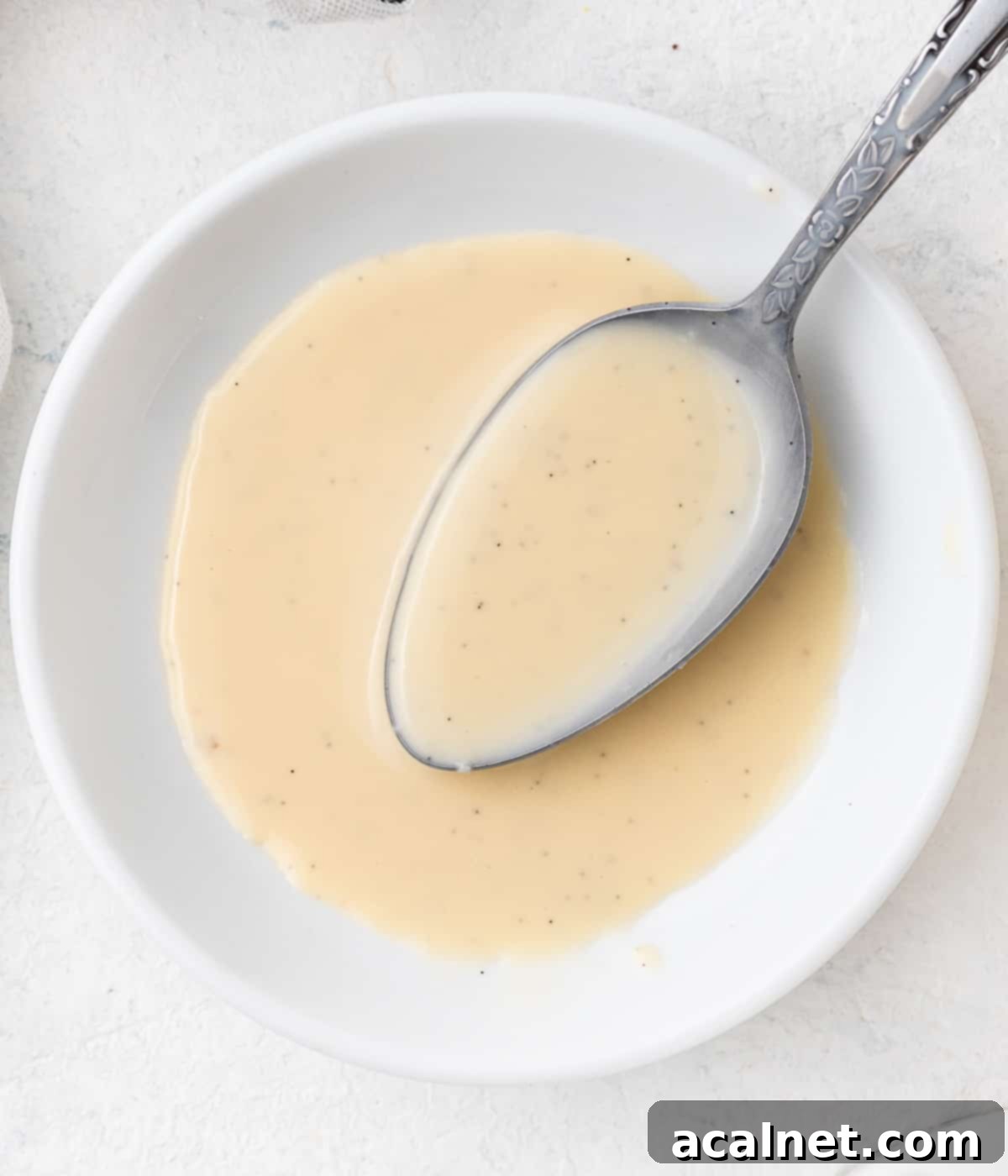
Elevate Your Desserts: Texture & Flavor Variations
While classic Vanilla Bean Crème Anglaise is exquisite on its own, its simple base makes it a fantastic canvas for experimentation. Here are some ideas to customize its texture and flavor:
- Achieve a Thicker or Richer Sauce: For a more substantial texture, you can replace a portion (or even all) of the milk with heavy/thickened cream. Alternatively, incorporating one additional egg yolk will also increase the richness and contribute to a slightly thicker consistency.
- Infuse with Aromatic Spices or Herbs: Introduce warmth and complexity by infusing the milk with whole spices like a cinnamon stick, a few cardamom pods, a pinch of nutmeg, or even fresh herbs such as mint or basil for a unique twist. Simply add them to the milk as it heats and remove before tempering.
- Indulge in Chocolate Crème Anglaise: Transform your vanilla custard into a chocolatey dream by whisking in some good quality cocoa powder to the milk mixture. For an even richer, more solidified chocolate experience, explore making Chocolate Crémeux, which is a thicker, more intense chocolate version.
- Brighten with Fruit Notes: For a refreshing twist, replace part (or all) of the milk with a strained fruit purée or fruit juice. Lemon juice can add a bright acidity, while strained strawberry, raspberry, or passion fruit purée can lend vibrant fruity flavors and colors.
- Flavor with Coffee or Tea: Give your custard an invigorating kick by infusing the milk with instant coffee granules, or steep a chai tea bag or matcha powder in the warm milk for an exotic, aromatic dessert sauce.
The Versatility of Crème Anglaise: Endless Uses
This simple yet elegant Crème Anglaise recipe is incredibly versatile, making it a staple in any dessert lover’s kitchen. Its delightful vanilla essence can be enjoyed both warm and cold, pairing beautifully with a wide array of dishes:
- As a Luxurious Sweet Sauce: Drizzle warm Crème Anglaise over slices of rich Chocolate Fondant Cake or a decadent Chocolate Hazelnut Cake. It’s also superb with fruit tarts and pies, such as a rustic French Apple Tart, adding a layer of creamy indulgence. For breakfast or brunch, elevate dishes like fluffy Brioche French Toast or pancakes with a generous pour of this vanilla custard.
- A Perfect Companion to Fruits: Simply serve Crème Anglaise chilled alongside a vibrant fruit salad, fresh berries, or poached fruits for a light yet satisfying dessert. The smooth custard beautifully complements the natural sweetness and tartness of the fruit.
- The Foundation for Other Gourmet Desserts: Crème Anglaise is an essential base for creating more elaborate and iconic French desserts. Use it to make a comforting bread pudding, a rich Chocolate Crémeux, a delicate Bavarian Cream, an indulgent Coffee Crème Brûlée, or a refreshing Passion Fruit Ice Cream. It’s also the secret ingredient for creamy Mascarpone Ice Cream, providing that signature smoothness and depth.
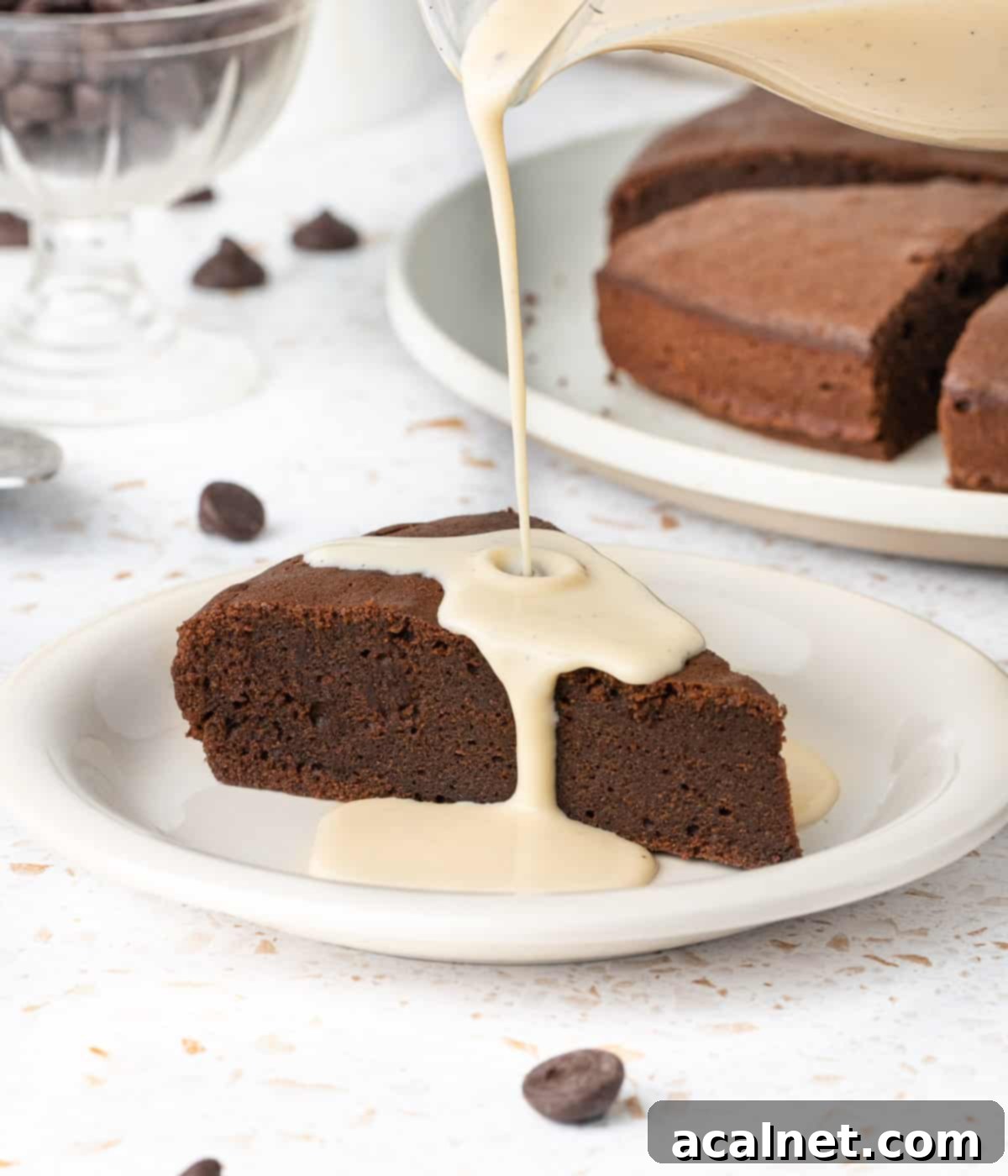
Pro Tips & Troubleshooting for Perfect Crème Anglaise
While Crème Anglaise is relatively simple, a few tricks can ensure a consistently smooth result. Here’s how to navigate common challenges and perfect your custard:
- Choosing Your Cooking Method (Saucepan vs. Double Boiler): The easiest way to prevent overcooking or scorching the cream is to use a double boiler (bain-marie). This method heats the custard more slowly and gently, giving you greater control over the temperature and significantly reducing the risk of scrambling the eggs. If using a direct saucepan, ensure your heat is very low and stir constantly.
- Preventing Crème Anglaise from Curdling: Curdling is primarily caused by excessive or sudden heat. Always cook the cream over a low to medium-low temperature. A rapid increase in heat or a sudden introduction of hot milk to cold eggs will cause the egg yolks to scramble. Consistent, gentle stirring is absolutely vital, as the bottom of the pan heats more quickly than the top, leading to uneven cooking.
- How to Salvage a Lumpy Custard: If your Crème Anglaise ends up lumpy or grainy, don’t despair! First, immediately pour the custard through a fine-mesh sieve. This will remove any larger bits of cooked egg. If it still appears grainy, you can try to slowly blend it with an immersion blender (stick blender) for a minute or two. This can often smooth out smaller lumps and restore a silky texture.
- Why Is My Crème Anglaise Not Thickening? Patience is key! Because we cook the mixture at a low temperature to protect the delicate egg yolks, it will take several minutes to visibly thicken. Remember that the cream will also continue to thicken as it cools. If you’ve cooked the cream to the correct temperature (82-84°C or 180-183°F) and it still seems too thin after cooling, it might indicate that your egg yolks were too small, or you may need to add one extra egg yolk next time for additional richness and thickening power.
Storing & Freezing Your Vanilla Custard Sauce
Once prepared, your beautiful Crème Anglaise can be served immediately while still warm, offering a delightful creamy warmth to your desserts. For later enjoyment, it can be stored in the refrigerator for up to three days. To store, first allow the cream to cool down slightly. Then, transfer it into a clean glass jar or an airtight container. To prevent a “skin” from forming on the surface (which can make the custard lumpy), gently place a piece of plastic wrap directly onto the surface of the cream before sealing the container. The custard will naturally thicken a bit more as it chills.
It is generally not recommended to freeze Crème Anglaise. The delicate emulsion can break down during the freezing and thawing process, potentially resulting in a grainy or separated texture that compromises its signature smoothness. For the best quality, always enjoy it fresh or refrigerated.
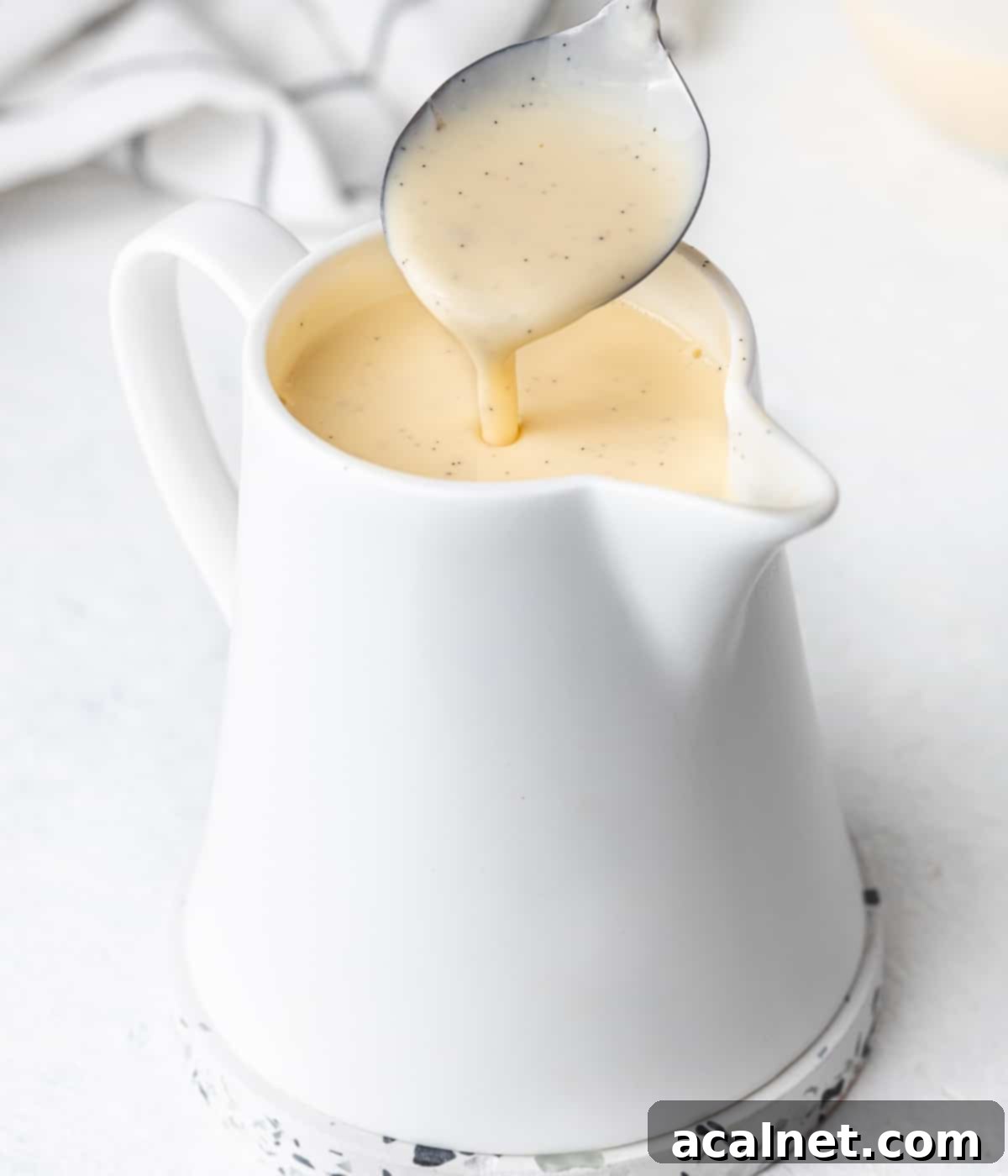
Explore More Basic French Creams and Pastries
If you’ve enjoyed mastering Crème Anglaise, you’ll love diving into these other essential French cream recipes. Expand your patisserie skills and discover new flavors and textures:
- Classic Vanilla Pastry Cream
- Decadent Chocolate Crémeux
- Light and Airy Diplomat Cream
- Feathery Crème Légère
- Rich Chocolate Pastry Cream
- Silky Bavarian Cream
- Smooth Chocolate Namelaka Cream
- Perfect Crème Chantilly
- Buttery Mousseline Cream
- Stabilized Mascarpone Whipped Cream
Made this recipe?
Let us know if you liked it by leaving a comment below, and tag us on Instagram @a.baking.journey with a photo of your creation!
Recipe Card

Crème Anglaise (Vanilla Custard Sauce)
Servings:
2
cups (500ml)
Author:
Sylvie
5 minutes
15 minutes
2 hours
1 hour
20 minutes
Print Recipe
Prevent your screen from going dark
Ingredients
- 500 ml (2 cups) Full Cream / Whole Milk
- 1 fresh Vanilla Bean, or 2 teaspoon Vanilla Paste
- 4 Egg Yolks, at room temperature
- 60 gr (1/4 cup) Caster Sugar
Instructions
- Place the milk in a small to medium saucepan. Slice the vanilla bean in half and scrape off the seeds with a small paring knife. Place the vanilla seeds and the leftover pod in the saucepan with the milk then turn on low heat. Occasionally stir until the milk starts to simmer. Remove from the heat and cover the saucepan with a lid. Leave to rest for 10 to 15 minutes then remove the vanilla pod (see note 1).
- While the milk is infusing, place the egg yolks and sugar in a large heat-proof bowl and whisk for 1 minute or just until combined. Slowly pour the hot milk mixture over the egg yolk mixture while constantly whisking (see note 2). Pour the whole mixture back into the saucepan and turn on low to medium-low heat.
- Cook for 5 to 10 minutes while constantly stirring with a heat-proof spatula or wooden spoon, or until the crème anglaise has thickened enough to coat the back of a spoon and has reached a temperature of 82 to 84 degrees Celsius (180 to 183 degrees Fahrenheit). Don’t let the mixture boil or it will overcook the eggs and you will get a lumpy custard.
- Optionally, strain the cream through a fine-mesh strainer to remove any lumps or bits of cooked eggs (see note 3).
- Use warm straight away or stored in the fridge in a clean jar / airtight container topped with plastic wrap touching its surface. The custard will thicken slightly more once cool.
Video
Would you like to save this recipe?
We’ll email this post to you, so you can come back to it later!
Notes
- This resting time will allow for the vanilla to infuse in the milk and give you more intense flavors. If you are using vanilla paste instead of a fresh vanilla bean, there is no need to infuse it. Make sure to keep the vanilla pod to make homemade vanilla extract for example.
- This step is called “tempering” and it allows to slowly raise the temperature of the eggs. A sudden change of temperature could make the egg curdles or burn.
- If you have overcooked the cream and still find it lumpy or grainy after having strained it, you can try to slowly mix it with an immersion blender to smooth it out.
Nutrition (per serving)
Carbohydrates: 43g |
Protein: 14g |
Fat: 18g |
Saturated Fat: 8g |
Polyunsaturated Fat: 2g |
Monounsaturated Fat: 6g |
Cholesterol: 420mg |
Sodium: 116mg |
Potassium: 427mg |
Sugar: 43g |
Vitamin A: 937IU |
Calcium: 364mg |
Iron: 1mg
